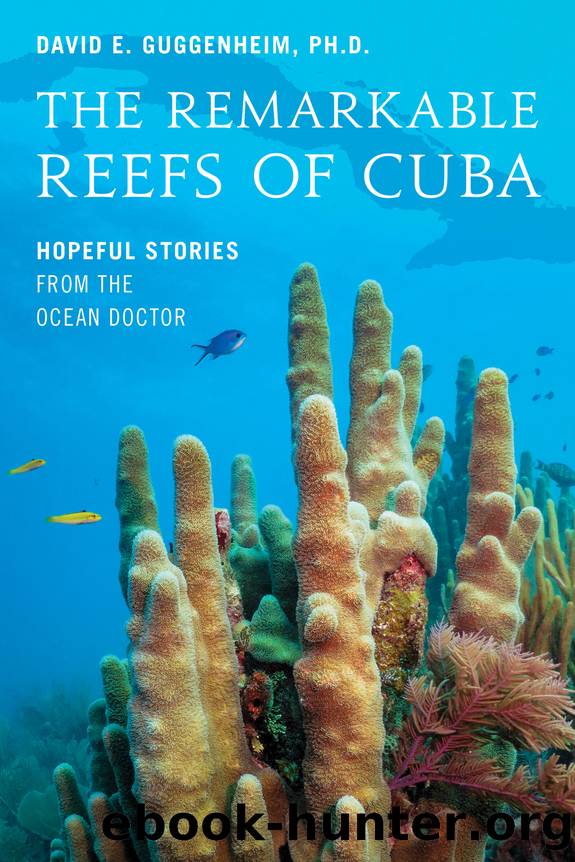The Remarkable Reefs of Cuba by David E. Guggenheim

Author:David E. Guggenheim
Language: eng
Format: epub, pdf
Publisher: Prometheus
Published: 2022-12-10T00:00:00+00:00
CHAPTER ELEVEN
THE WORK OF A GIANT
Like music and art, love of nature is a common language that can transcend political or social boundaries.
âJimmy Carter
Spanruslish
Of course, I gave Ana MarÃa my blessing to order beef, as I did to the others at the table. It became clear that in 2000 the memory of the Special Period remained freshâa decade of hunger we rapidly fattening Americans might never understand. I myself was terribly ignorant that this chapter of Cuban history had even existed and felt terribly insensitive for not understanding how Cubans were still nursing their wounds when I first arrived there. Over the years, I have learned that few Americans are aware that such an inconceivable crisis of suffering for Cubans had taken place just under 100 miles south of the well-stocked pantries of the United States; breaking bread with their American friends was a special and appreciated pleasure.
Along with Ana MarÃa, I met CIMâs director, Dr. MarÃa Elena Ibarra, during that first visit to Cuba. My university Spanish had rusted to the point of being practically unusable, supplanted by a spattering of Russian from my days working in the Soviet Union and, of course, the fact that I had married a Soviet. Many Cubans spoke English, though MarÃa Elena and Ana MarÃa spoke little. Their generation learned Russianâtoday Cuban students are taught English. So we soldiered on in âSpanruslish,â an odd combination of the three languages. We not only understood one another but enjoyed the beginning of a warm bond that would endure for many years. We all shared a deep commitment to studying and protecting the sea and this was something that would transcend the formidable politics that would constantly threaten to thwart our efforts.
There is a long and rich history of scientific collaboration between Cuba and the United States that stretches back as far as the mid-1800s. That history of collaboration has included the marine sciences as well, including the Tomás Barrera Expedition in 1914 focused on marine and terrestrial mollusks, and a 1914 expedition by Paul Bartsch and John B. Henderson to collect fish species. There were brief exchanges of the Cuban Academy of Sciences with the Smithsonian Institution, the New York Botanical Gardens, the American Museum of Natural History, Harvard University, and several NGOs throughout the 1980s and 1990s. But in retrospect, it seems that long-term, sustained scientific collaborationâcertainly in marine scienceâbegan in the late 1990s and early 2000s and blossomed over the years following. (When speaking of scientific collaboration, Sergio Pastrana never misses a moment to boast that the Cuban Academy of Sciences was founded before the U.S. Academy of Sciences.)
After that first meeting, it became immediately clear to me that to understand CIM, and to understand marine science in Cuba, you needed to understand Cubaâs Mother Ocean, Dr. MarÃa Elena Ibarra.
Download
The Remarkable Reefs of Cuba by David E. Guggenheim.pdf
This site does not store any files on its server. We only index and link to content provided by other sites. Please contact the content providers to delete copyright contents if any and email us, we'll remove relevant links or contents immediately.
| Cell Biology | Developmental Biology |
| Entomology | Marine Biology |
| Microbiology | Molecular Biology |
| Biostatistics |
Sapiens: A Brief History of Humankind by Yuval Noah Harari(14256)
The Tidewater Tales by John Barth(12609)
Mastermind: How to Think Like Sherlock Holmes by Maria Konnikova(7231)
Do No Harm Stories of Life, Death and Brain Surgery by Henry Marsh(6891)
The Thirst by Nesbo Jo(6832)
Why We Sleep: Unlocking the Power of Sleep and Dreams by Matthew Walker(6620)
Life 3.0: Being Human in the Age of Artificial Intelligence by Tegmark Max(5478)
Sapiens by Yuval Noah Harari(5295)
The Longevity Diet by Valter Longo(5021)
The Body: A Guide for Occupants by Bill Bryson(4976)
The Rules Do Not Apply by Ariel Levy(4866)
The Immortal Life of Henrietta Lacks by Rebecca Skloot(4528)
Animal Frequency by Melissa Alvarez(4399)
Why We Sleep by Matthew Walker(4362)
The Hacking of the American Mind by Robert H. Lustig(4319)
Yoga Anatomy by Kaminoff Leslie(4309)
All Creatures Great and Small by James Herriot(4233)
Double Down (Diary of a Wimpy Kid Book 11) by Jeff Kinney(4208)
Embedded Programming with Modern C++ Cookbook by Igor Viarheichyk(4105)
